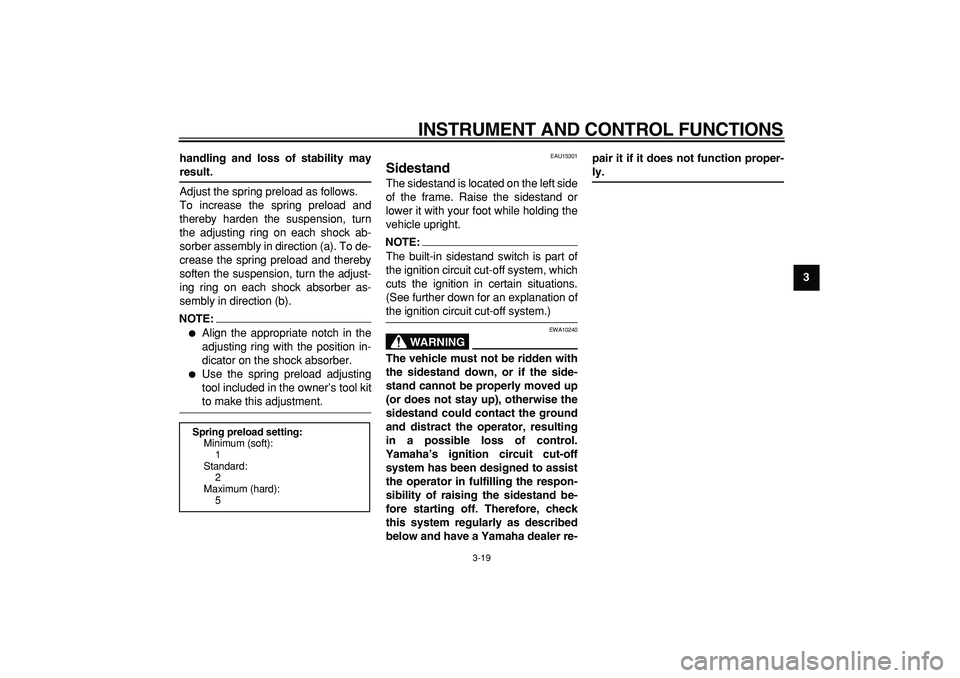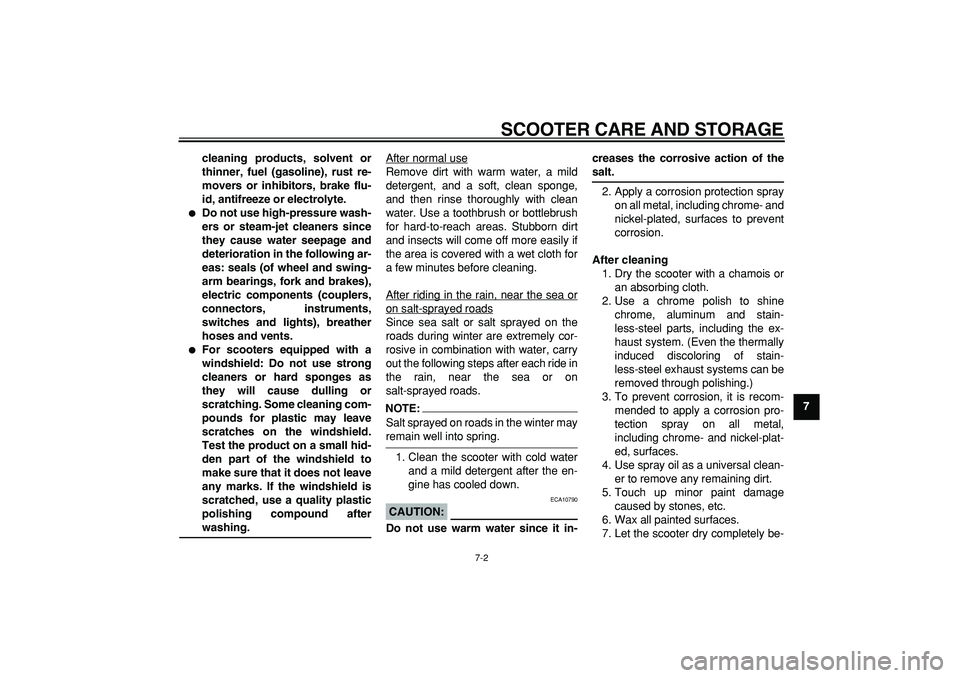Page 35 of 98

INSTRUMENT AND CONTROL FUNCTIONS
3-19
2
34
5
6
7
8
9 handling and loss of stability may
result.
Adjust the spring preload as follows.
To increase the spring preload and
thereby harden the suspension, turn
the adjusting ring on each shock ab-
sorber assembly in direction (a). To de-
crease the spring preload and thereby
soften the suspension, turn the adjust-
ing ring on each shock absorber as-
sembly in direction (b).
NOTE:
�
Align the appropriate notch in the
adjusting ring with the position in-
dicator on the shock absorber.
�
Use the spring preload adjusting
tool included in the owner’s tool kit
to make this adjustment.
EAU15301
Sidestand
The sidestand is located on the left side
of the frame. Raise the sidestand or
lower it with your foot while holding the
vehicle upright.
NOTE:
The built-in sidestand switch is part of
the ignition circuit cut-off system, which
cuts the ignition in certain situations.
(See further down for an explanation of
the ignition circuit cut-off system.)
WARNING
EWA10240
The vehicle must not be ridden with
the sidestand down, or if the side-
stand cannot be properly moved up
(or does not stay up), otherwise the
sidestand could contact the ground
and distract the operator, resulting
in a possible loss of control.
Yamaha’s ignition circuit cut-off
system has been designed to assist
the operator in fulfilling the respon-
sibility of raising the sidestand be-
fore starting off. Therefore, check
this system regularly as described
below and have a Yamaha dealer re-pair it if it does not function proper-
ly.
Spring preload setting:
Minimum (soft):
1
Standard:
2
Maximum (hard):
5
Page 48 of 98

PERIODIC MAINTENANCE AND MINOR REPAIR
6-4
1
2
3
4
5
6
7
8
9
9*
Brake hoses
�
Check for cracks or damage.
√√√√√
�
Replace. Every 4 years
10
*
Wheels
�
Check runout and for damage.
√√√√
11
*
Tires
�
Check tread depth and for
damage.
�
Replace if necessary.
�
Check air pressure.
�
Correct if necessary.
√√√√√
12
*
Wheel bearings
�
Check bearing for looseness or
damage.
√√√√
13
*
Steering bearings
�
Check bearing play and steer-
ing for roughness.
√√√√√
�
Lubricate with lith-
ium-soap-based grease.Every 20000 km (12000 mi)
14
*
Chassis fasteners
�
Make sure that all nuts, bolts
and screws are properly tight-
ened.
√√√√√
15
Front brake lever
pivot shaft
�
Lubricate with silicone grease.
√√√√√
16
Rear brake lever
pivot shaft
�
Lubricate with silicone grease.
√√√√√
17
Sidestand, center-
stand
�
Check operation.
�
Lubricate.
√√√√√
18
*
Sidestand switch
�
Check operation.
√√√√√√
19
*
Front fork
�
Check operation and for oil
leakage.
√√√√
20
*
Shock absorber
assemblies
�
Check operation and shock
absorbers for oil leakage.
√√√√
21
*
Fuel injection
�
Check engine idle speed.
√√√√√√
NO. ITEM CHECK OR MAINTENANCE JOBODOMETER READING
ANNUAL
CHECK 1000 km
(600 mi)10000 km
(6000 mi)20000 km
(12000 mi)30000 km
(18000 mi)40000 km
(24000 mi)
Page 77 of 98
PERIODIC MAINTENANCE AND MINOR REPAIR
6-33
2
3
4
5
67
8
9 er, have a Yamaha dealer
charge your battery.
EAU42820
Replacing the fuses
The main fuse and the fuse box, which
contains the fuses for the individual cir-
cuits, are located behind cowling A.
(See page 6-7.)
If a fuse is blown, replace it as follows.
1. Turn the key to “OFF” and turn off
the electrical circuit in question.
2. Remove the blown fuse, and then
install a new fuse of the specified
amperage.
NOTE:
If the main fuse is blown, remove the
grab bar to access the main fuse. After
replacing the main fuse, install the grab
bar. (See page 6-7.)
(for non-ABS models)
1. Spare main fuse
2. Main fuse
1. Fuse box
2. Hazard fuse
1
2
1
2
Page 78 of 98
PERIODIC MAINTENANCE AND MINOR REPAIR
6-34
1
2
3
4
5
6
7
8
9(for ABS models) (for non-ABS models) (for ABS models)
1. Fuse box
2. ABS motor fuse
3. ABS control unit fuse
4. Hazard fuse
1
2
4 3
1. Ignition fuse
2. Signaling system fuse
3. Headlight fuse
4. Radiator fan fuse
5. Backup fuse (for odometer and clock)
6. Fuel injection system fuse
7. Spare fuse
7
123456
1. Ignition fuse
2. Signaling system fuse
3. Headlight fuse
4. Radiator fan fuse
5. Backup fuse (for odometer and clock)
6. Fuel injection system fuse
7. Spare fuse
7
123456
Page 79 of 98
PERIODIC MAINTENANCE AND MINOR REPAIR
6-35
2
3
4
5
67
8
9
CAUTION:
ECA10640
Do not use a fuse of a higher amper-
age rating than recommended to
avoid causing extensive damage to
the electrical system and possibly a
fire.
3. Turn the key to “ON” and turn on
the electrical circuit in question tocheck if the device operates.
4. If the fuse immediately blows
again, have a Yamaha dealer
check the electrical system.
EAU34240
Replacing a headlight bulb
This model is equipped with quartz bulb
headlights. If a headlight bulb burns
out, have a Yamaha dealer replace it
and, if necessary, adjust the headlight
beam.
Specified fuses:
Main fuse:
40.0 A
Ignition fuse:
10.0 A
Signaling system fuse:
10.0 A
Headlight fuse:
25.0 A
Hazard fuse:
10.0 A
Radiator fan fuse:
10.0 A
Fuel injection system fuse:
10.0 A
ABS control unit fuse:
YP400A 10.0 A
ABS motor fuse:
YP400A 30.0 A
Backup fuse:
10.0 A
Page 87 of 98

SCOOTER CARE AND STORAGE
7-2
2
3
4
5
6
78
9 cleaning products, solvent or
thinner, fuel (gasoline), rust re-
movers or inhibitors, brake flu-
id, antifreeze or electrolyte.
�
Do not use high-pressure wash-
ers or steam-jet cleaners since
they cause water seepage and
deterioration in the following ar-
eas: seals (of wheel and swing-
arm bearings, fork and brakes),
electric components (couplers,
connectors, instruments,
switches and lights), breather
hoses and vents.
�
For scooters equipped with a
windshield: Do not use strong
cleaners or hard sponges as
they will cause dulling or
scratching. Some cleaning com-
pounds for plastic may leave
scratches on the windshield.
Test the product on a small hid-
den part of the windshield to
make sure that it does not leave
any marks. If the windshield is
scratched, use a quality plastic
polishing compound after
washing.
After normal use
Remove dirt with warm water, a mild
detergent, and a soft, clean sponge,
and then rinse thoroughly with clean
water. Use a toothbrush or bottlebrush
for hard-to-reach areas. Stubborn dirt
and insects will come off more easily if
the area is covered with a wet cloth for
a few minutes before cleaning.
After riding in the rain, near the sea oron salt-sprayed roadsSince sea salt or salt sprayed on the
roads during winter are extremely cor-
rosive in combination with water, carry
out the following steps after each ride in
the rain, near the sea or on
salt-sprayed roads.NOTE:
Salt sprayed on roads in the winter may
remain well into spring.
1. Clean the scooter with cold water
and a mild detergent after the en-
gine has cooled down.
CAUTION:
ECA10790
Do not use warm water since it in-creases the corrosive action of the
salt.
2. Apply a corrosion protection spray
on all metal, including chrome- and
nickel-plated, surfaces to prevent
corrosion.
After cleaning
1. Dry the scooter with a chamois or
an absorbing cloth.
2. Use a chrome polish to shine
chrome, aluminum and stain-
less-steel parts, including the ex-
haust system. (Even the thermally
induced discoloring of stain-
less-steel exhaust systems can be
removed through polishing.)
3. To prevent corrosion, it is recom-
mended to apply a corrosion pro-
tection spray on all metal,
including chrome- and nickel-plat-
ed, surfaces.
4. Use spray oil as a universal clean-
er to remove any remaining dirt.
5. Touch up minor paint damage
caused by stones, etc.
6. Wax all painted surfaces.
7. Let the scooter dry completely be-
Page 91 of 98

SPECIFICATIONS
8-2
2
3
4
5
6
7
89
Secondary reduction ratio:
42/16 (2.625)
Transmission type:
V-belt automatic
Operation:
Centrifugal automatic type
Chassis:
Frame type:
Aluminum die-cast and steel tube back-
bone
Caster angle:
27.00 °
Trail:
100.0 mm (3.94 in)
Front tire:
Type:
Tubeless
Size:
120/80-14M/C 58S
Manufacturer/model:
IRC/MB67
Manufacturer/model:
DUNLOP/D305FL
Rear tire:
Type:
Tubeless
Size:
150/70-13M/C 64S
Manufacturer/model:
IRC/MB67
Manufacturer/model:
DUNLOP/D305L
Loading:
Maximum load:
YP400 189 kg (417 lb)
YP400A 185 kg (408 lb)
* (Total weight of rider, passenger, cargo
and accessories)
Tire air pressure (measured on cold
tires):
Loading condition:
0–90 kg (0–198 lb)
Front:
200 kPa (29 psi) (2.00 kgf/cm
2
)
Rear:
250 kPa (36 psi) (2.50 kgf/cm
2
)
Loading condition:
YP400 90–189 kg (198–417 lb)
YP400A 90–185 kg (198–408 lb)
Front:
200 kPa (29 psi) (2.00 kgf/cm
2
)
Rear:
250 kPa (36 psi) (2.50 kgf/cm
2
)
Front wheel:
Wheel type:
Cast wheel
Rim size:
14M/C x MT3.00
Rear wheel:
Wheel type:
Cast wheel
Rim size:
13M/C x MT4.00
Front brake:
Type:
Dual disc brake
Operation:
Right hand operation
Recommended fluid:
DOT 4
Rear brake:
Type:
Single disc brake
Operation:
Left hand operation
Recommended fluid:
DOT 4
Front suspension:
Type:
Telescopic fork
Spring/shock absorber type:
Coil spring/oil damper
Wheel travel:
120.0 mm (4.72 in)
Rear suspension:
Type:
Unit swing
Spring/shock absorber type:
Coil spring/oil damper
Wheel travel:
104.0 mm (4.09 in)
Electrical system:
Ignition system:
Transistorized coil ignition (digital)
Charging system:
AC magneto
Page 92 of 98
SPECIFICATIONS
8-3
1
2
3
4
5
6
7
8
9Battery:
Model:
GT9B-4
Voltage, capacity:
12 V, 8.0 Ah
Headlight:
Bulb type:
Halogen bulb
Bulb voltage, wattage
×
quantity:
Headlight:
12 V, 60 W/55.0 W
×
2
Tail/brake light:
LED
Front turn signal light:
12 V, 21.0 W
×
2
Rear turn signal light:
12 V, 21.0 W
×
2
Auxiliary light:
12 V, 5.0 W
×
2
License plate light:
12 V, 5.0 W
×
1
Meter lighting:
12 V, 2.0 W
×
3
High beam indicator light:
12 V, 1.4 W
×
1
Turn signal indicator light:
12 V, 1.4 W
×
2
Engine trouble warning light:
12 V, 1.4 W
×
1
ABS warning light:
YP400A 12 V, 1.4 W
×
1
Immobilizer system indicator light:
LED
Fuses:
Main fuse:
40.0 A
Headlight fuse:
25.0 A
Signaling system fuse:
10.0 A
Ignition fuse:
10.0 A
Radiator fan fuse:
10.0 A
Hazard fuse:
10.0 A
Fuel injection system fuse:
10.0 A
ABS control unit fuse:
YP400A 10.0 A
ABS motor fuse:
YP400A 30.0 A
Backup fuse:
10.0 A